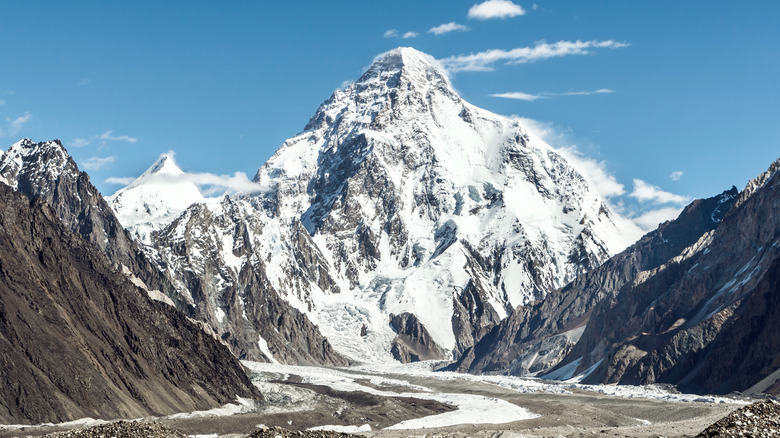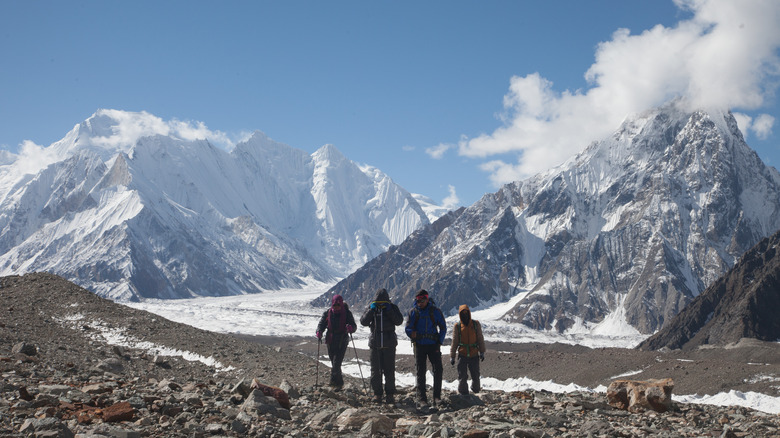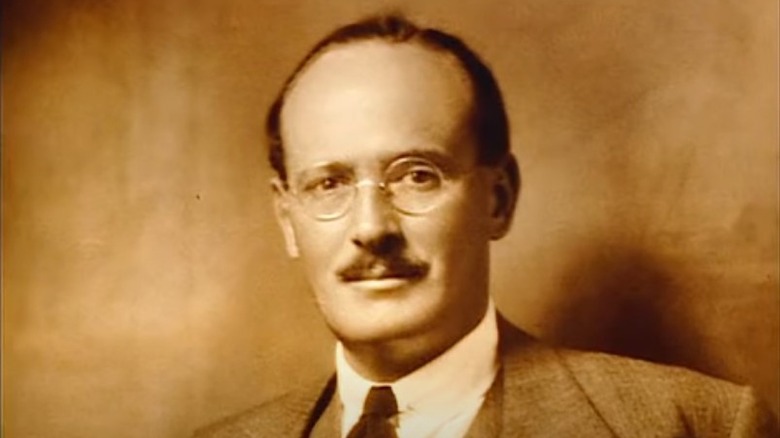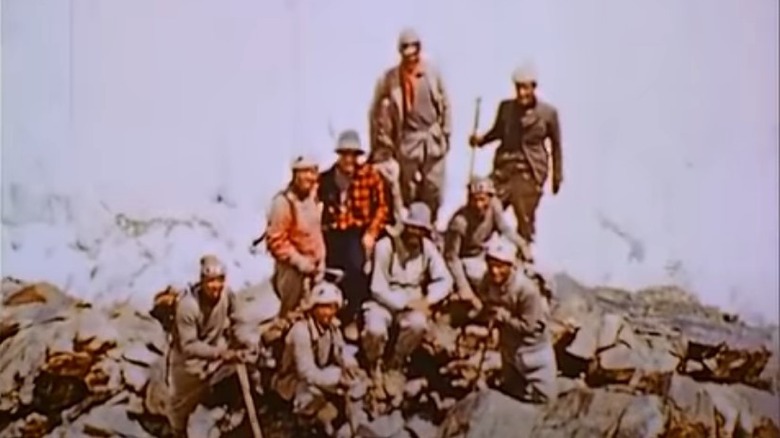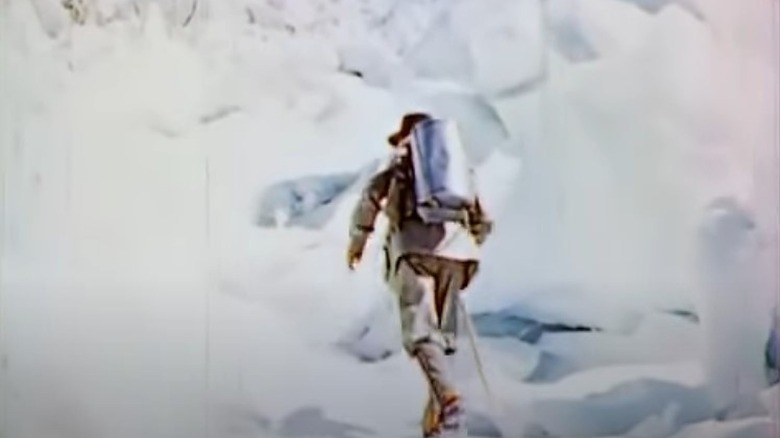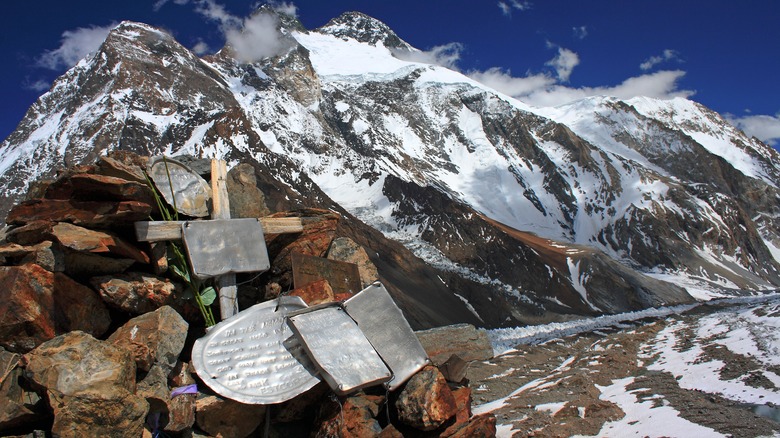Inside The Failed Mountain Rescue Of Dudley Wolfe On The Side Of K2
You're probably familiar with the challenges of climbing Mount Everest, the world's tallest mountain at 29,032 feet above sea level. But mountaineering experts agree that K2 (or Mount Godwin-Austen), the world's second highest peak at 28,251 feet, is a lot harder to climb (via World Data). According to The New York Times, one in 34 people die trying to reach the summit of Everest; in K2, the death toll goes up to a very scary 1 in 4 people. That's a 4% versus a 29% fatality rate (per Insider).
K2 is a tricky mountain to climb for many reasons. Even getting to Base Camp is no walk in the park. On Everest, Base Camp can be reached via a long but relatively easy hike, while K2's Base Camp requires a climb/trek over a glacier from difficult-to-access Pakistan (via Insider). Things only get harder from there. K2's weather is more unpredictable, the climbing is more technical, and there are fewer groups going up the mountain, so help is less likely to be available if you run into trouble. Overall, Insider points out, there's a 40% chance nobody will reach the summit of K2 in any given year, but there are climbers who summit almost every year on Everest.
And while Everest has a higher fatality count, that's only because more people attempt the climb. National Geographic reports that as of 2018, more than 4,000 have reached the summit of Everest, but fewer than 400 can say the same about K2.
Attempting to reach the summit
In 1954, an Italian expedition was the first ever to reach the summit of K2, just a year after Everest had also been conquered (via Much Better Adventures). By then, climbers had been trying to climb K2 for half a century without luck. It wasn't until 1938, however, that the first proper reconnaissance of the mountain was completed, when the First American Karakoram Expedition managed to establish Base Camp at 16,600 feet, surveying different routes, and placing ropes, but eventually turning back just 2,250 feet shy of the summit because of lack of supplies and poor weather (via American Alpine Club).
When the Second American Karakoram Expedition, led by German climber Fritz Wiessner, arrived in 1939, things were looking promising, but it all changed very quickly. The 1939 party was originally supposed to include 10 people, including returning climbers from the year before, but the number soon dwindled to only six, most of whom had very limited climbing experience. One of the climbers was American socialite Dudley Wolfe, who would eventually become known as "K2's first victim" (per American Alpine Club).
Despite the team's inexperience, they could have potentially made it to the summit if not for a series of events that started before the team even left Base Camp, and eventually resulted in tragedy. One significant problem was the lack of certain equipment; at least one of the climbers didn't have the proper footwear, and the team didn't have enough snow goggles, which led to snow blindness for some of the porters (Sherpas), forcing them to turn back (per American Alpine Club).
Tragedy strikes
The remaining members of the expedition soon started to lose hope for a successful summit. Eventually, only three members of the expedition reached Camp VII at 24,000 feet, including Wolfe. To their dismay, they found the camp almost empty, with no supplies waiting for them and nothing to eat or warm up. Confused and exhausted, the trio separated, with Wolfe remaining at Camp VII while the other two team members attempted to reach the summit. After two failed attempts to summit, the pair gave up, but by then a week had passed and Wolfe was too weak to join them in the descent (via American Alpine Club).
A deal was made that Wolfe would remain at Camp VII while the other two team members reached the next camp for supplies, but they soon discovered all camps below were also empty or dismantled. There's much discussion regarding why this happened, but historians speculate some kind of miscommunication resulted in the Sherpas not bringing enough supplies to the camps (via El Pais).
Regardless of why, the two explorers soon reached Base Camp while Wolfe remained up the mountain, alone. It would be almost another full week before a team would reach Wolfe on July 29, but by that point he was too weak to climb down. Provisions were left with a promise to return for him, according to the American Alpine Club.
The aftermath
Rescuers tried again on July 31, but the bad weather made the climb impossible and of the three climbers attempting the rescue, only one made it back down; the two Sherpas in the group disappeared on the mountain and have never been found. As reported by the American Alpine Club, a third rescue attempt was made in early August, with similar results, and by August 9, everybody still on the mountain was presumed dead. The expedition left K2. No more attempts would be made to summit K2 until 1953, which also ended in tragedy, with no one reaching the summit and no signs of Wolfe's or the Sherpas' remains (via American Alpine Club).
For years after, the survivors blamed each other for the failed expedition and the death of Wolfe. Leader Fritz Wiessner blamed Jack Durrance, a pre-medical student who had joined the expedition at the last minute and taken over the responsibility to supply the camps, while others said Wiessner, as the team leader, should have been better prepared (per American Alpine Club). But the truth is that in the 1930s, the understanding of what happens to the human body at high altitudes was poor at best. Add to that the fact that Wolfe had only been allowed to join the expedition because he was the main financial supporter of it, and this despite him being obviously too inexperienced and out of shape to attempt such a climb. Regardless of who was at fault, Wiessner's reputation never recovered, says Suburban Mountaineer.
A mystery is solved
While K2 was finally conquered in 1954 when an Italian team reached the summit, the mystery of what happened to Wolfe (seen above in a colorized still from the original 1939 film) wouldn't be solved until much later. It wasn't until 2002 that author and filmmaker Jennifer Jordan and award-winning independent filmmaker Jeff Rhoads accidentally stumbled upon Wolfe's remains (via Outside Magazine).
The pair was walking around the base of the mountain with a group of small people when Jordan found a number of objects on the ground. As she reported to Outside Magazine, this included hemp rope and "double-layer pants and Primus stove burners — stuff that hadn't been used in decades." Just a few steps away, she also found a series of bones, which The Guardian describes as belonging to the waist and legs, as well as pieces of a canvas tent. If there was any doubt about who the remains belonged to, Rhoads then discovered a mitten with the name Wolfe on it. The first man to die on K2 had finally been found.
While Jordan certainly wasn't looking for Wolfe that day, she says it wasn't the first time she'd found debris from historical expeditions, as things on K2 tend to slide down the mountain during storms, avalanches, or are simply pushed down by the wind (via Outside Magazine). But this had certainly been one of the most important discoveries ever at the foot of the second tallest mountain in the world.
The last goodbye
There has never been a clear explanation of how Wolfe ultimately died, but spending time at such altitude without oxygen tanks, without food, and without proper insulation likely proved a deadly combination. According to the climbers walking with Jordan in 2002, it's likely that "Wolfe died alone in his tent or near to it" and that none of the three Sherpas who went missing ever reached him (via The Guardian).
Wolfe's remains were buried at the Gilkey Memorial, a man-made pile of stones located on K2's base camp. Built as a memorial to those who lost their lives on the mountain and named after the American climber who lost his life there in 1953, the Gilkey Memorial is a long and tiring walk over the Godwin-Austen Glacier (via Dawn). Only those who make a real effort get to see the stones and the metal plaques that have been added to remember those who dared challenge K2.
When Wolfe died in 1939, The Boston Globe published a piece that started with the words "Boston sportsman died July 30 on Mt. Godwin Austen, India, with guide." It described Wolfe as "one of the best mountain climbers in Switzerland." But whether that's true or he had just joined the group to try to impress his ex-wife (as the rumor goes), Wolfe will forever be one of those claimed by K2 (per The Guardian).
